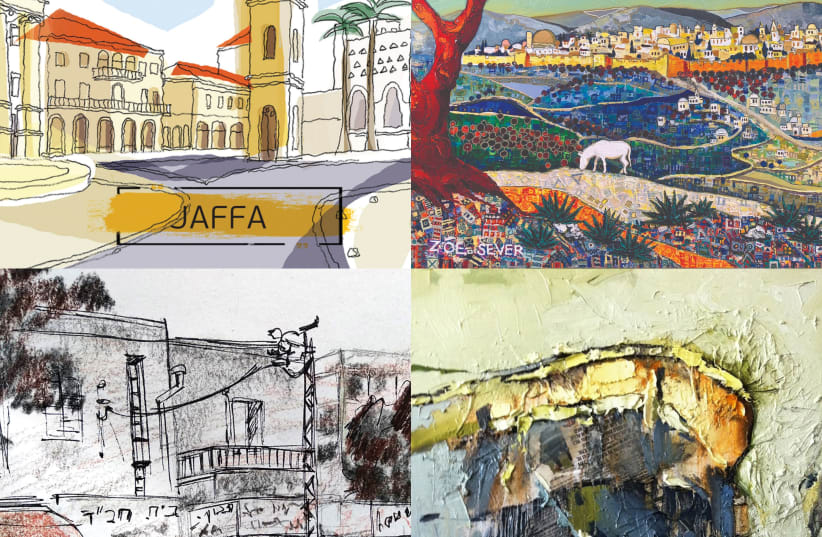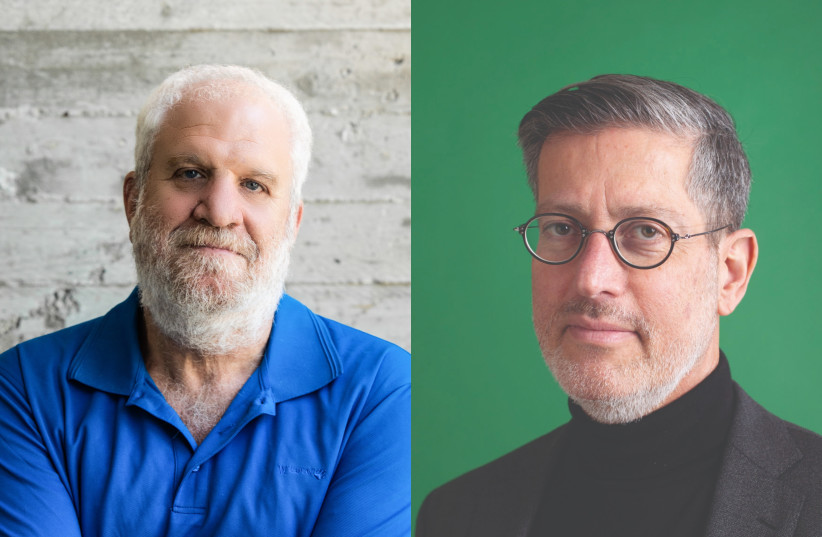‘Art is not what you see, but what you make others see,” said Edgar Degas, the famous French Impressionist artist. A fascinating exhibit of postcards depicting scenes of Israel, illustrated by 36 Soviet-born artists, provides a window of not only how they view their adopted homeland but also of the images that they want us to see.
On October 20, the “Yoffi shel Israel” (The beauty of Israel) exhibition was launched at the Jerusalem House of Quality, 12 Hebron Road, Jerusalem. Yoffi, a family-owned business that produces and markets Israeli gastronomic souvenirs sold in Israel and around the world, joined with The Jerusalem Post and embarked on a new initiative – creating memories of Israel through visual images.
With the support of Israeli-Russian businessman Roman Abramovich, the company commissioned 36 Soviet-born Israelis to create postcards that combine ancient and modern scenes of the Land of Israel. The postcards include depictions of local personalities, historical monuments, and breathtaking landscapes alongside the wonders of hi-tech progress.
The Post shared the images with some of the leading figures in the local art scene – Isaac Weiss, general manager of the Jerusalem House of Quality, where the exhibition is being held; Prof. Sheizaf Rafaeli, president of Shenkar College of Engineering and Design in Ramat Gan, and Prof. Adi Stern, president of the Bezalel Academy of Art and Design in Jerusalem.
Do immigrant artists look at Israel differently than native-born Sabras? Weiss suggests that Russian immigrant artists view Israel differently than those born in this country. “Sabras are accustomed to the landscape, to the heat, and different places in the country,” says Weiss. “Immigrants from Russia who come from different cultures and climates see the country with fresh eyes.
“Native-born Israelis were born into our landscapes, whereas these artists who have made aliyah meet them for the first time, which creates a completely different look that is reflected in their paintings.”
Stern, from Bezalel, adds, “I’ve always been intrigued by the foreigner’s gaze, the outsider’s observation. What do I see while traveling the world that the locals don’t see? What do those who immigrated to Israel from a northern culture, that is rich with tradition and heritage, see? How do they perceive it?
“What do they think of us, the Sabras, who were born here? How do they understand the Israeli public space – what catches their eye? What, if at all, evokes memories from home? What looks especially different and alien?
Stern says that he found “Sea Chair,” an image created by Julia Stotskaya, who made aliyah from Moscow in 2016 and lives in Jerusalem, particularly captivating. “While thinking of cross-cultural journeys, we often look for symbols – images we can relate to, typical objects that encapsulate and signify the local culture.
“The Keter plastic chair is in many respects the essence of being Israeli – not necessarily pretty or elegant, but very durable, sturdy, clever, effective and simple. The postcard holds a magical sea world, above and underwater, that brings together sea plants and creatures with the all-Israeli industrial object. It’s a beautiful way to look at the beauty of our country.”
WEISS, FROM the Jerusalem House of Quality, enjoyed studying all the images, but particularly enjoyed the postcards designed by Irina Peres, Mike Kaplan, and Tatiana Ratush.
Why did he chose the work of those three artists?
“The paintings of these artists reflect the bright light and special colors of the sky, stones, and vegetation in Israel as they appear to the artists. In my opinion, these artists captured the special atmosphere of the country and managed to perpetuate it in their paintings.”
Weiss adds that designing art on postcards “gives a personal and unique dimension – no longer part of globalization but instead, [has] a local dimension with nostalgia for a simple past.”
Rafaeli has headed Shenkar College of Engineering, Design in Ramat Gan since 2020, and says, “all the paintings in the postcards are beautiful. It is difficult – and perhaps not even proper – to choose one image over another. I loved the painting of the boy who defined himself as ‘special,’ ” referring to the postcards created by 13-year-old Valentin Stefashin, the autistic son of artist Irina Peres.
Rafaeli particularly enjoyed the image of Jerusalem with a nearby olive tree, painted by artist Zoe Sever, who made aliyah from Ukraine in 1990, and today lives in Givatayim; the Impressionist painting of Tel Aviv by Aron Kravits, who made aliyah in 1995, and has created artistic and sculptural set decoration for Tel Aviv and Jerusalem theaters, including the Israeli Opera; and Inna Zaks’ painting of Kfar Saba. Zaks, who made aliyah in 2018, currently resides there.
Rafaeli explains his particular attraction to these three postcards: “These are three very different paintings of different places in Israel, each with a unique artistic approach. The three paintings, as a group, are a testament to the diversity of this country and its people, its landscapes, and the experience of migrating to it.
“Most of us are immigrants or descendants of immigrants who came here and whose absorption experience was mixed with foreignness and fear, apprehension, and newness. The combination of these three illuminates what, for me, is the wealth of opportunities, the difference in experiences, and the diversity in the backgrounds.
“Aliyah was once called kibbutz galuyot, the ingathering of the exiles, the ‘melting pot,’ and sometimes ‘the pressure cooker.’ No matter the chosen metaphor and how one chooses to accept the process of absorption, it is a combination of rich flavors and ingredients that integrate and enrich one another.”
Rafaeli says that while the artists each have different styles, they share the identity of being an oleh at a specific time, and they have the authority and the right to be different and special, each in their own way.
“This is what is wonderful about this exhibit. It encourages one to continue to be optimistic about the absorption of immigrants.”
“Yoffi shel Israel” is open to the public at the Jerusalem House of Quality, 12 Hebron Road, Jerusalem, through November 15. It is supported by Russian-Israeli businessman Roman Abramovich, and is a joint venture of Yoffi and The Jerusalem Post. The event is organized by Skizza, a cultural center for Russian-speaking Israelis.
This article was written in cooperation with Yoffi.


